We’ve trashed the Yarra for 190 years. Can we really save it in 45?
Landscape architects swap cars and golfers for bots and billabongs in the NGV’s 2070 vision for our much-maligned river.
By Ray Edgar
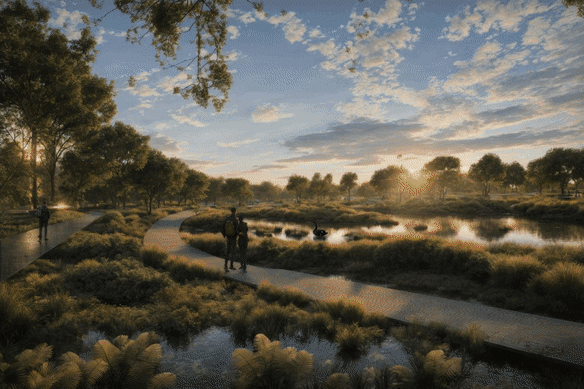
Credit: NGV
In 2070, the Yarra River will not only be swimmable, it will be entirely walkable. The Great Birrarung Parkland will extend continuously from South Yarra to the river’s upper reaches. Golf courses along its banks will be transformed into public parks. Platypuses will swim within city limits, native vegetation will proliferate along its banks, billabongs will refill, “Birrabots” (underwater drones) will clean the river of pests and invasive species.
This optimistic vision forms a new NGV exhibition, Reimagining Birrarung, which gives the river back its dignity and majesty. Eight landscape architecture practices (see below) were invited to speculate on how the Birrarung could fulfil the ambition of a strategic plan that envisions the return to a more natural, pre-colonial state. In the Woi-wurrung language, the plan is called Burndap Birraung burndap umarkoo, which translates as “good for Yarra is good for all”.
The 50-year plan was a requirement of the 2017 Yarra River Protection Act, the first legislation in Australia to recognise the river and its land as one living, integrated natural entity. Its priorities include the restoration of billabongs, the improvement of water quality for greater biodiversity, and the expansion of parklands and trails to provide continuous access.
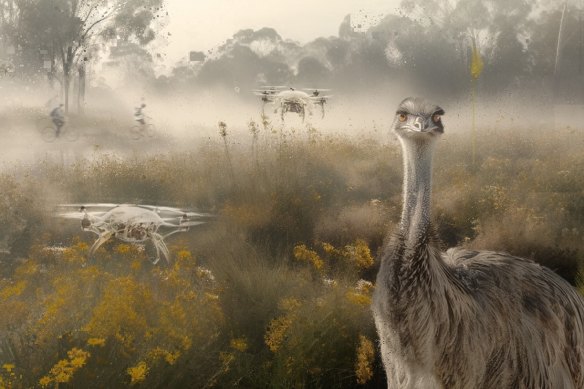
REALMstudios’ postcards from the future: Emus on the golf-course grass plains.Credit: REALMstudios
“The strategic plan … is the foundation of what we are doing,” says Ewan McEoin, senior design curator at the NGV. “We asked designers to help the community to understand what it might look like in practice.”
Each landscape architecture firm looked at a different segment of the river, and one, McGregor Coxall, considered the catchment as a whole. One ambitious proposal in the exhibition suggests the partial removal of the South Eastern Freeway in favour of native vegetation and public transport. There’s even a board game.
The NGV began by holding workshops and consultation sessions with Birrarung Council, which advises the State Government, and Wurundjeri elders to understand their hopes for the river. The exhibition itself fulfils one of the goals of the plan – promoting and celebrating the river’s cultural heritage.
Around the world, cities are recognising the importance of healthy rivers. The Paris Olympics was the latest high-profile effort. But where the French used engineering to clean the Seine, Australian landscape architects typically opt for ecological solutions. A combination of natural systems like wetlands cleanse the water before it hits the river, and absorb it back into the ground. Litter traps are used at the end of drains and on the river.
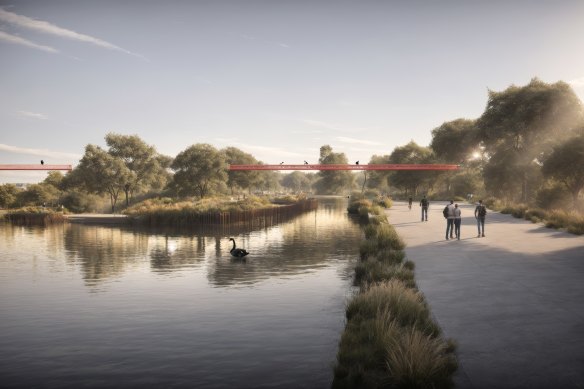
ASPECT Studios’ Kirsten Bauer says landscape architects “design a process that may go for hundreds of years”.Credit: ASPECT Studios
“Paris is a megacity – they don’t have all the space for all these wetlands, like literally a green sponge system,” says Kirsten Bauer, global design director of ASPECT Studios, one of the firms taking part in the exhibition.
Reimagining Birrarung is the NGV’s first landscape architecture exhibition. It highlights a profession whose skills encompass everything from designing furniture to creating wide-ranging master plans. “Some projects are the size of small countries,” says Miranda Wilkinson, associate director of McGregor Coxall.
The exhibition’s timeline emphasises the profession’s long-term focus. “A landscape is not instant,” says Bauer. “You design a process that may go for hundreds of years, hopefully. It’s culture, science and art working together.”
While the river takes centre stage in the exhibition, people benefit too. “As the Wurundjeri elders said, ‘if you take care of the river, the river takes care of you’,” says Bauer.
“With increased urbanisation, we need ecological environments to help with the heat-island effect and climate change. Population and housing density will also drive demand for more large-scale community spaces.”
Against this backdrop, perhaps the most controversial proposition is to allow flooding – or “seasonal flows”, as landscape architects prefer to call it.
“Rivers aren’t static entities,” says McEoin. “The Birrarung is a line on a map, but that line has moved over thousands of years.” Each team agreed that natural processes should return to the river – there are, for example, quick wins to be found in golf courses, which are built on flood plains.
“More people go to the Botanic Gardens, but the golf courses are four times as big,” says Bauer. “There are an enormous amount of golf courses along the Yarra that aren’t publicly accessible. It’s questioning the best use of that land.”
The strategic plan emerged through community engagement, and will continue to evolve. “This exhibition is there to help people imagine what is possible,” says McEoin.
“The role of the public is to imagine the future that they want. Then start asking for it.”
ASPECT Studios
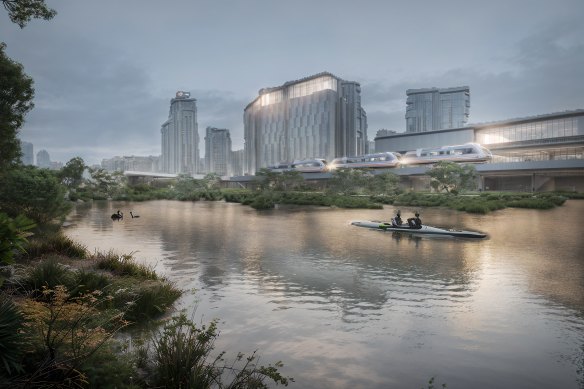
ASPECT Studios’ plan partially removes the South Eastern Freeway.Credit: Aspect Studios
Along a 4-kilometre stretch of South Yarra and Richmond, Aspect transforms the Birrarung into an urban forest. Deciding on the width was easy. “Whatever was in the old flood line determined which areas to take back,” says Bauer. Colonial-era land contracts have also been redressed – no longer does ownership extend to the middle of the river. In place of private lands, ASPECT reconstructs wetlands and billabongs. A new north-south parkland provides movement for people, plants and animals. A pedestrian bridge links Como Park to Herring Island. In its biggest move, ASPECT partially removes the South Eastern Freeway and repurposes it as a public transport system.
REALMstudios
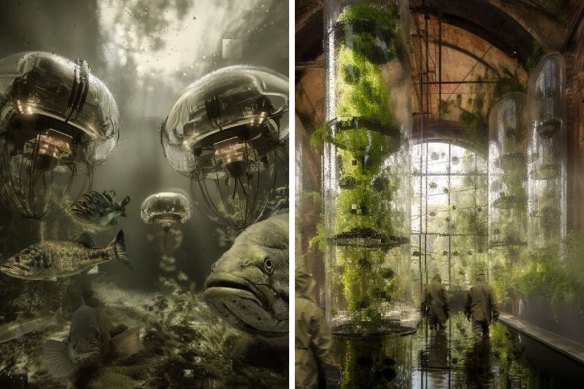
Postcards from the future includes the river-cleaning Birrabot.Credit: REALMstudios
How can advanced technology protect and nurture the environment? REALMstudios imagines a flotilla of sub-aquatic drones dubbed Birrabots. Incorporating bio-mimetic features inspired by aquatic life, the drones move efficiently underwater, monitoring water quality, detecting pollutants and ensuring that the chemical composition of the river remains healthy. The Birrabots also control invasive species and manage the restored river bass population, a species crucial to the river’s ecosystem.
Openwork
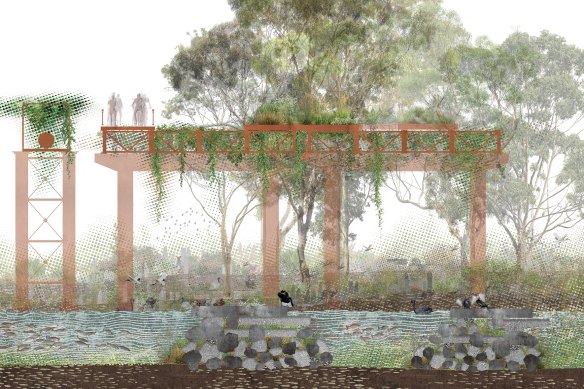
Manningham Road Bridge, 2070.Credit: Openwork
“The river at the moment is the place where all care runs out,” says Openwork’s Mark Jacques. “It’s absolutely a dead zone.” Existing on the border between councils, the Yarra is a place where “electricity towers march through, Manningham Road Bridge obliterates everything underneath – there’s no sunlight that gets down to the bank – and suburban stormwater spews into the river without much treatment”.
Openwork repurposes the infrastructure between Heidelberg and Bulleen that blights the Birrarung’s banks. Manningham Road Bridge, for example, becomes a habitat for fauna while providing pedestrian connections. Importantly, Openwork also shifts the council boundaries so that the river becomes the centre of governance.
OFFICE
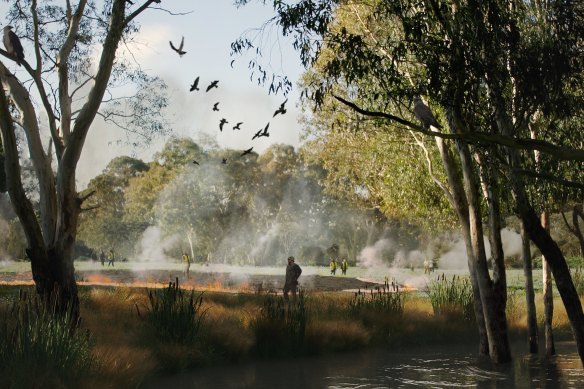
Aqua Nullius reclaims privatised spaces, with a vision of future Aboriginal custodianship.Credit: OFFICE
Office scrutinises four golf courses in Kew and Ivanhoe (two public, two private) built across a system of ancient billabongs. “You can see the billabongs through the water traps of the golf course,” says OFFICE’s Simon Robinson. “We’re interested in this layering of time.”
The title of the project, Aqua Nullius – a riff on terra nullius – translates as “nobody’s water”. “It’s this idea colonisers didn’t think the water belonged to anyone,” says Robinson. “That denies Aboriginal people’s relationship to water.”
After speaking with traditional owners, Office proposes reclaiming the privatised spaces and reintroducing flood, fire and care cycles, suggesting that “in the future [the Birrarung] be entirely Aboriginal-run”.
Bush Projects
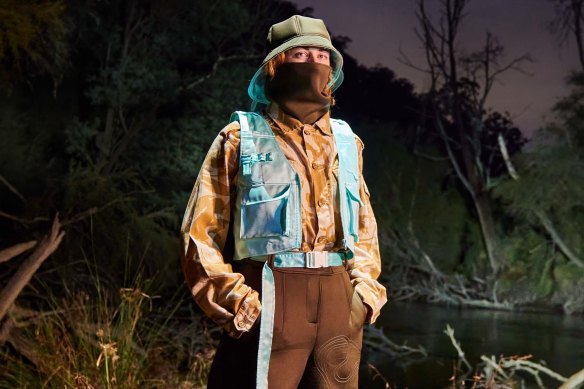
Bio-zone Guide Uniform.Credit: Bush Projects
Proposing the public acquisition of a tract of private agricultural land, Bush Projects imagines a 1500-hectare Birrarung Bio-zone. The protected ecological habitat spans the upper Birrarung floodplain around Yarra Glen and Yering. Within the bio-zone, the Birrarung’s seasonal water-flow cycles have been reinstated. Removing agricultural infrastructure accelerates landscape regeneration. Seasonal water flows now spread freely across the floodplain and downstream, dispersing and activating the seed bank. Bush Projects also designed a uniform for the volunteers and ecologists who support the bio-zone.
TCL
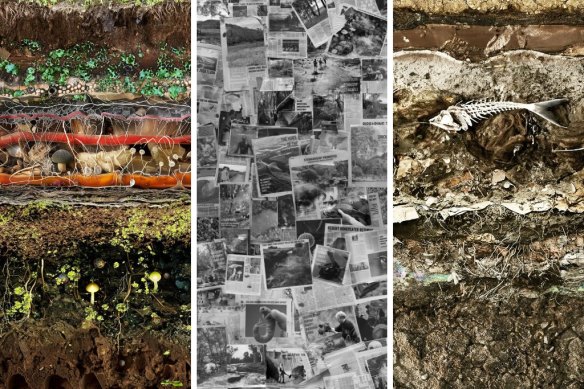
TCL’s entry includes cross sections of the land around Yering and news articles promoting the campaign for change.Credit: TCL
The river near Yering features rolling hills, bushland, billabongs and a gorge. It’s also the source of Melbourne’s drinking water. “On the surface, it’s a really lovely natural environment,” says TCL director Lisa Howard. “We wanted to reveal what’s beneath the surface.”
Because the area is heavily used for agriculture, fertilisers and pesticides permeate the ground and water source. Through 10 “core samples” – cross sections of the land – TCL chronologically displays the soil improvement that can occur with a shift away from pesticides.
McGregor Coxall
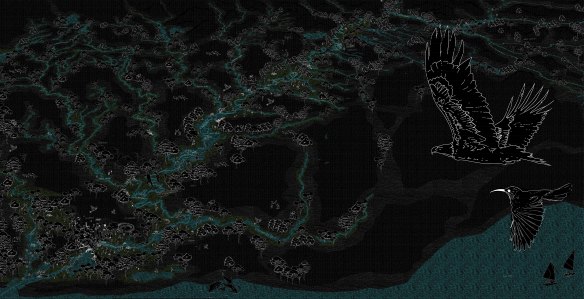
The Great Birrarung Parkland 2070.Credit: McGregor Coxall
McGregor Coxall’s animation, Past Present Future Birrarung, tracks the evolution of the Yarra, exploring the historical impact of climate, population, urbanisation, pollution, deforestation and land-management practices. The projection then looks forward to simulate land-management practices that establish the Great Birrarung Parkland, suggesting that the degradation that has occurred could be reversed.
“It’s trying to emphasise the river’s existence for 100 million years,” says Miranda Wilkinson, associate director with McGregor Coxall. “You can very clearly see the … damage … Could there not be amazing change in such a short time in the future in the opposite direction?”
SBLA
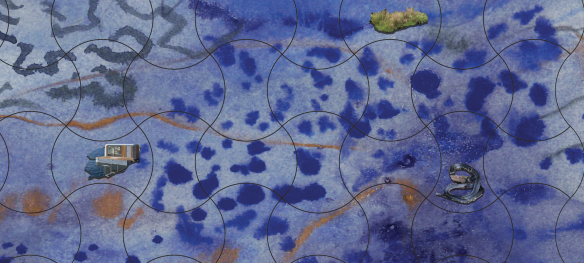
No OfFence but you are the problem: the Birrarung board game.Credit: SBLA
Play is an essential part of SBLA’s approach to landscape architecture. “It’s an effective way of getting people excited and involved,” says creative director Simone Bliss.
SBLA’s board game – “no ofFence but you are the problem” – allows players to assume the roles of different characters, from a red gum tree to a farmer to an Indigenous elder, all relying equally on the Birrarung for existence.
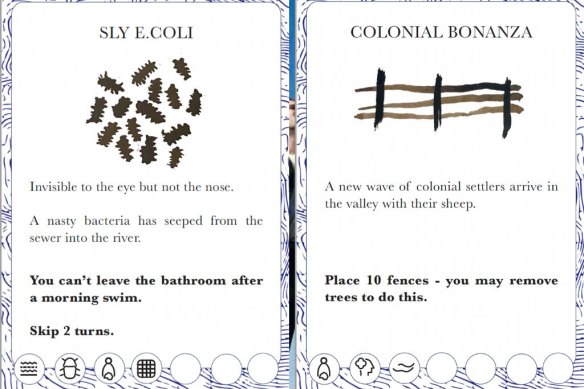
Cards from the No OfFence but you are the problem Birrarung board game. Credit: SBLA
“We are trying to say everyone needs to form a relationship with our own environment,” says Bliss. “It’s all about using mythology, ecology and social capital cards to get your own agenda heard. It’s a take on how we separate ego from eco.”
All the cards have goals, but Bliss says the game is never-ending. “However, when you play it’s obvious if you are working with the river you will win, but if not, you’re up shit creek.”
Reimagining Birrarung: Design Concepts for 2070 is at NGV Australia, August 23, 2024 to February 2, 2025.